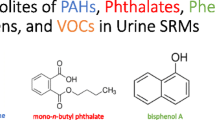Summary
The objective of this study was to assess individual human exposure to volatile halogenated hydrocarbons (VHH) under normal environmental conditions by means of biological monitoring, i.e. by the measurement of these compounds or their metabolites in body fluids, such as blood, serum, and urine. Blood samples of 39 normal subjects without known occupational exposure to these agents were examined for the occurrence of VHH. The following compounds were present in quantifiable concentrations in 60 to 95% of the blood samples examined: chloroform (median 0.2 μg/l; range < 0.1–1.7 μg/l), 1,1,1-trichloroethane (median 0.2 μg/l; range < 0.1–3.4 μg/l), tetrachloroethylene (median 0.4 μg/l; range < 0.1–3.7 μg/l). Trichloroethylene could be detected in 31% of all blood samples (median < 0.1 μg/l; range < 0.1–1.3 μg/l). In addition, the levels of trichloroacetic acid (TCA) were determined in serum and 24-h urine samples of 43 and 94, respectively, normal subjects. TCA was present in measurable concentrations in all serum and urine samples examined. The median of the TCA levels in serum was 21.4 μg/l (range 4.8–221.2 μg/l) and in urine 6.0 μg/24 h (range 0.6–261.4 μg/24 h). The results are discussed in relation to data from the literature on human exposure to VHH from the general environment, i.e. via air, food, and water. The upper normal limits calculated from the results of this investigation can be used to detect even minor excessive exposures to VHH.
Similar content being viewed by others
References
Aurand K, Fischer M (1981) Gefährdung von Grund- und Trinkwasser durch leichtflüchtige Chlorkohlenwasserstoffe. WaBoLu-Berichte 3/1981. D Reimer Verlag, Berlin-W
Bauer U (1981) Belastung des Menschen durch Schadstoffe in der Umwelt — Untersuchungen über leicht flüchtige organische Halogenverbindungen in Wasser, Luft, Lebensmitteln und im menschlichen Gewebe. I.–IV. Mitteilung. Zbl Bakt Hyg I. Abt Orig B 174:15–38, 174:39–56, 174:200–237, 174:556–583
DFG (Deutsche Forschungsgemeinschaft) (1985) Maximale Arbeitsplatzkonzentrationen und Biologische Arbeitsstofftoleranzwerte 1985. Mitteilung XXI der Senatskommission zur Prüfung gesundheitsschädlicher Arbeitsstoffe. Verlag Chemie, Weinheim
DVGW (Deutscher Verein des Gas- und Wasserfaches e.V.) (1981) Halogenkohlenwasserstoffe in Grundwässern. DVGW-Schriftenreihe Wasser, Nr 29. ZfGW-Verlag, Frankfurt/M
Düszeln J von, Lahl U, Bätjer K, Cetinkaya M, Stachel B, Thiemann W (1982) Vorkommen flüchtiger Halogenkohlenwasserstoffe in Luft, Wasser und Lebensmitteln in der Bundesrepublik Deutschland. Dtsch Lebensm Rundsch 78:352–356
Henschler D, Elsässer H, Romen W, Eder E (1984) Carcinogenicity study of trichloroethylene, with and without epoxide stabilizers, in mice. J Cancer Res Clin Oncol 107:149–156
Herbolsheimer R, Funk L (1974) Gaschromatographische Bestimmung von Trichloräthylen, Trichloräthanol, Trichloressigsäure und Äthanol in einem Analysengang aus einer Probe. Arch Toxicol 32:209–215
IARC (International Agency for Research on Cancer) (1982) IARC Monographs on the Evaluation of the Carcinogenic Risk of Chemicals to Humans [Suppl 4] Lyon 1982
Lahl U, Cetinkaya M, von Düszeln J, Stachel B, Thiemann W (1981) Health risks from volatile halogenated hydrocarbons? Sci Total Environ 20:171–189
MAGS (Ministerium für Arbeit, Gesundheit und Soziales des Landes Nordrhein-Westfalen) (1982) Luftreinhalteplan Rheinschiene Mitte 1981–1986. Düsseldorf
MAGS (1984) Luftreinhalteplan Rheinschiene Süd, 1. Fortschreibung, 1982–1986. Düsseldorf
MAGS (1985) Luftreinhalteplan Ruhrgebiet West, 1. Fortschreibung, 1984–1988. Düsseldorf
Monster AC (1979) Difference in uptake, elimination and metabolism in exposure to tri chloroethylene, 1,1,1-trichloroethane and tetrachloroethylene. Int Arch Occup Environ Health 42:311–317
Monster AC, Boersma G, Duba WC (1979a) Kinetics of trichloroethylene in repeated exposure of volunteers. Int Arch Occup Environ Health 42:283–292
Monster AC, Boersma G, Steenweg H (1979b) Kinetics of 1,1,1-trichloroethane in volunteers; influence of exposure concentration and work load. Int Arch Occup Environ Health 42:293–301
Monster AC, Boersma G, Steenweg H (1979c) Kinetics of tetrachloroethylene in volunteers; influence of exposure concentration and work load. Int Arch Occup Environ Health 42:303–309
Selenka F, Bauer U (1984) Belastung der Bevölkerung in der Bundesrepublik Deutschland durch flüchtige organische Halogenverbindungen aus Trinkwasser, Luft und Lebensmitteln. Abschlußbericht zum DFG-Forschungsvorhaben Organohalogene, Se-182/9 (1.4.1980–31.3.1982) Bochum
Wallace LA, Pelizzari ED, Hartwell TD, Sparacino CM, Sheldon LS, Zelon H (1985) Personal exposures, indoor-outdoor relationships, and breath levels of toxic air pollutants measured for 355 persons in New Jersey. Atmos Environ 19:1651–1661
WHO (1981) Recommended health-based limits in occupational exposure to selected organic solvents. Technical Report Series No 664, Geneva
Zartner-Nyilas G (1984) Kontamination der Umwelt durch leichtflüchtige aliphatische chlorierte Kohlenwasserstoffe. Bericht im Auftrag des Bund-Länder-Arbeitskreises Umweltchemikalien (BLAU). Landesanstalt für Umweltschutz Baden-Württemberg, Karlsruhe
Ziglio G, Fara GM, Beltramelli G, Pregliasco F (1983) Human environmental exposure to trichloro- and tetrachloroethylene from water and air in Milan, Italy. Arch Environ Contam Toxicol 12:57–64
Zimmerli B, Zimmermann H, Müller F (1982) Perchloräthylen in Nahrungsmitteln. Mitt Gebiete Lebensm Hyg 73:71–81
Author information
Authors and Affiliations
Rights and permissions
About this article
Cite this article
Hajimiragha, H., Ewers, U., Jansen-Rosseck, R. et al. Human exposure to volatile halogenated hydrocarbons from the general environment. Int Arch Occup Environ Health 58, 141–150 (1986). https://doi.org/10.1007/BF00380765
Received:
Accepted:
Issue Date:
DOI: https://doi.org/10.1007/BF00380765




